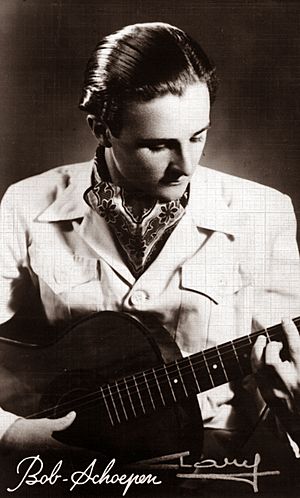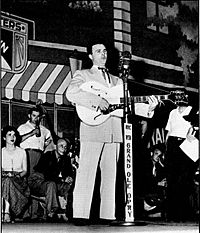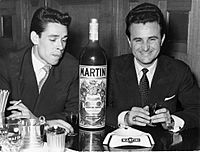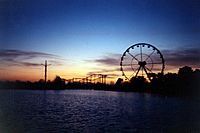Bobbejaan Schoepen facts for kids
Quick facts for kids
Bobbejaan Schoepen
|
|
|---|---|

ca. 1943
|
|
| Background information | |
| Birth name | Modest Schoepen |
| Born | 16 May 1925 |
| Origin | Boom, Antwerp, Flanders, Belgium |
| Died | 17 May 2010 (aged 85) |
| Genres | Twang Folk Pop Country Cabaret Film music |
| Instruments | Vocals Guitar Art whistling Ukulele Harmonica Yodeling |
| Years active | 1935–2010 |
| Labels | Decca Records, World Music Company, Sony BMG, EMI, PIAS, Bobbejaan Records |
Bobbejaan Schoepen (whose real name was Modest Schoepen) was a very important Belgian musician. Born on May 16, 1925, he passed away on May 17, 2010. He helped create pop and country music in Europe. Bobbejaan was a talented singer, songwriter, guitarist, comedian, actor, and amazing whistler. He also started and ran the famous amusement park Bobbejaanland.
His music career was very successful from 1948 until the mid-1970s. He sold over five million copies of his 482 songs! His music included many styles, like country, folk, pop, and even songs for movies. Bobbejaan grew up in a working-class family in Boom, Belgium. He worked hard to become one of the richest people in Belgium.
Bobbejaan married Josephina (Josée) Jongen, a former opera singer, on May 18, 1961. They had five children: Robert (born 1962), Myriam (1963), Jacky (1964), Peggy (1968), and Tom (1970). His son Tom later became his manager in Belgium.
Contents
- Early Music Days
- Traveling the World and Finding Success
- Tours with a Circus Tent: 1958–1961
- Film Roles
- Bobbejaanland (The Amusement Park)
- Becoming an Entrepreneur
- Challenges and Selling the Park
- Comeback to Music
- Final Years
- In Other Media
- Awards and Honors
- Five Biggest International Hits
- Artist Names He Used
- Films He Appeared In
- See also
Early Music Days
Modest Schoepen grew up in a smithy (a place where metal is worked) in Boom. He started performing in the late 1930s with his sister Liesje. They put on vaudeville shows (a type of entertainment with different acts) in nearby villages. After their shows, they would collect money from the audience.
In 1943, he began taking classical guitar lessons. His first radio audition was in 1944 in Brussels.
First Big Performance
In 1943, Bobbejaan had a memorable first performance at the Ancienne Belgique in Brussels. The place was packed! He sang a South African song called "Mama, ek wil 'n man hé." The song was seen as being against the German forces at the time. Some people in the audience who supported the Germans tried to take him away. The Ancienne Belgique theater was closed for three weeks because of this.
After this, he faced difficulties and chose to sing for Belgian workers who were forced to work in Germany. Because of this, he was held for three months in a place called the Dossin barracks in Mechelen in 1944.
Two Boys and Two Guitars
In 1945, he formed a music group with Kees Brug, a friend from his village. They called themselves "Two Boys and Two Guitars." They performed different acts, including poetry, South African songs, and country music. They traveled from Calais, France, to Amsterdam, Netherlands, always adding new things to their shows.
The name "Bobbejaan" comes from a South African song, "Bobbejaan klim die berg" ("Baboon Climbs the Mountain"). Modest Schoepen started using "Bobbejaan" as his stage name around 1945 or 1946.
Performing for Soldiers
In 1947, Bobbejaan met Jacques Kluger, who asked him to entertain American and Canadian soldiers. These soldiers were in Germany for important events like the Nuremberg Trials. Bobbejaan performed in Frankfurt and Berlin. Major Mearker, an American officer, was very impressed and wrote a kind letter about Bobbejaan. This led to Bobbejaan touring Germany for several months.
In Berlin, which was still partly in ruins from the war, his shows were even attended by American General Lucius D. Clay. The General asked him to perform two more times! These tours helped Bobbejaan develop his country music style even more.

First Hit Song and Indonesia Tour
Even while touring abroad, Bobbejaan also performed in Belgium. At first, he didn't want to sing in Dutch. But Jacques Kluger convinced him to record a "Flemish record." In 1948, his first recordings came out, and "De Jodelende Fluiter" ("The Yodeling Whistler") became his first big hit! He also became very popular in the Netherlands that year.
In 1949, he toured Indonesia to perform for Dutch soldiers. He did 127 shows in just three months! The Dutch government honored him for his bravery because he performed for soldiers even near the front lines. Five days after returning home, he started a 220-day tour across Belgium. He sang popular songs like "De lichtjes van de Schelde" ("The Lights of the Scheldt") from 1952. This song is still very well-known in Belgium today. Bobbejaan Schoepen quickly became one of the most popular artists in Flanders.
Traveling the World and Finding Success

Bobbejaan Schoepen toured in at least twenty different countries. He performed with famous artists like Josephine Baker and Toots Thielemans. Toots Thielemans was even a guitarist in Bobbejaan's band in 1951.
Bobbejaan was one of the first European artists (not from the UK) to perform at the Grand Ole Opry in Nashville. This is one of the most important places for country music in the United States. In 1953, he played there three times with country star Roy Acuff. He also performed with Red Foley in Springfield, Missouri. Later, American country singer Tex Williams even covered Bobbejaan's song "Fire and Blisters" in the US in 1974.
1954 Tours and Awards
In 1954, Bobbejaan went on a three-month tour across Europe. He visited Germany, Iceland, and Denmark. This tour ended with several months of shows at the Folies Bergère in Brussels. By January 1955, when Jacques Brel performed in Brussels, Bobbejaan was already a huge international star in Belgium.
He was chosen as the best Flemish singer by the broadcasting company NIR (now VRT). He received the "Grand Prize for Flemish Gramophone Recording" for this honor. That autumn, he toured Germany for a month, and then the Congo for another month.
1957 Tours and Eurovision
In 1957, he went to New York again. He was invited to appear as a guest on the famous The Ed Sullivan Show. He also recorded albums with RCA Records and producer Steve Sholes. Sholes offered him a contract to promote his music in the US, using the name "Bobby John." However, Bobbejaan had been touring almost non-stop for ten years. He also had other commitments in Europe. He was looking for a place to settle down, which would later become Bobbejaanland. So, he decided not to continue pursuing success in the US.
That same month, he became Belgium's representative at the second Eurovision Song Contest 1957. His manager, Jacques Kluger, quickly brought him from the US to Germany for the event. His performance was special because it included a whistling solo! The song he performed was "Straatdeuntje" ('Street Tune'). Belgium tied for eighth place with Switzerland.
1958 Tours and Big Hits
A year later, in 1958, Kluger arranged for Bobbejaan to perform in the "Royal Variety Show" in England. This is a yearly gala for the Queen Mother (Elizabeth Bowes-Lyon). After the show, his manager in England, Jack Heath, played him the first Australian hit song in the US, "A Pub with No Beer" by Slim Dusty. Bobbejaan decided to record his own versions in Dutch, German, and English.
In 1960, his German version, "Ich steh an der Bar und ich habe kein Geld," stayed on the German music charts for thirty weeks! It also became a number-one hit in Austria. The Flemish version, "Café zonder bier," came out in 1959 and reached number 3 on the charts. It later became a classic song.
More Hits and Tours
His German versions of "Een hutje op de Heide" ("Little cottage on the Heath") and "Kili Watch" also did very well. Bobbejaan often toured in Germany and Austria with artists like Caterina Valente (in 1955) and Dalida (in 1961). These tours brought him many new opportunities. In 1961, he was one of the top musical acts at the Berlin Film Festival. He amazed the audience at the Deutschlandhalle with his incredible whistling acts.
During the 1960s, other artists like Camillo Felgen and James Last helped make his song "Ik heb eerbied voor jouw grijze haren" ("I Respect Your Grey Hair") a huge European hit. It sold over three million copies! In 1961, Caterina Valente also released a version of "In de schaduw van de mijn" ("In the Shadow of the [Coal] Mine") in Italy. In 1965, Richard Anthony sang a French and Spanish version of "Ik heb me dikwijls afgevraagd" (Je me suis souvent demandé). This song reached number 1 in France in April 1965. In 1965, Bobbejaan, who wrote the music, received an artistic award in Paris.
In 1967, the German TV channel ZDF decided to make a musical film featuring his hit songs. Parts of the film were recorded in Prague, in the Kempen region of Belgium, and in Bobbejaanland. At that time, Bobbejaanland was still just a theater without rides.
In the 1960s and 1970s, he often visited the United States. There, he met actor Roy Rogers, fashion designer Nudie Cohn (who designed clothes for Elvis and Johnny Cash), and Tex Williams. These four sometimes performed together in local clubs.
Tours with a Circus Tent: 1958–1961
In 1958, Bobbejaan Schoepen bought a large circus tent. This allowed him to tour more easily in Belgium. He no longer had to deal with music venue owners who charged high rental prices or didn't have enough space. He took over the tent from the Tondeur family, who were struggling to make their shows profitable. Bobbejaan took charge, and the circus shows became successful again. The day before a show, he would often promote it himself in a fun way.
In 1959, Schoepen bought a new circus tent that could hold 900 people, and even up to 1,200. These tent tours stopped when Bobbejaanland opened its doors in 1961. Using a circus tent for concert tours was very unusual and creative for that time.
Film Roles
Between 1950 and 1967, Bobbejaan acted in five musical films. Two were Belgian, two German, and one was German-Czech. In 1962, he played the main role in a comedy called At the Drop of a Head. He wasn't very happy with this film experience, saying it was "chaotic."
In 1999, a Belgian rock band called Dead Man Ray toured with this film. They saw it as a tribute to Bobbejaan's amazing artistic talents. They described him as a true professional who turned his guitar playing, deep voice, and funny humor into his own unique style, and later into an amusement park.
Bobbejaanland (The Amusement Park)
Bobbejaan never planned to build an amusement park. His famous park grew out of his music career. After almost 15 years of constant touring, he wanted a place to settle down. In 1959, he bought a large, marshy area of land in Lichtaart-Kasterlee, Belgium. It was called the Abroek.
There, he built a theater with almost 1000 seats and created a 2.2-kilometer beach. This became Bobbejaanland, a name suggested by his manager, Jacques Kluger. On December 31, 1961, Bobbejaanland officially opened. Bobbejaan Schoepen and his wife Josée worked together to turn the park into their life's dream.
During the busy season, Bobbejaan himself would perform two to five concerts every day! Other artists from Belgium, the Netherlands, and Germany also performed there.
Becoming an Entrepreneur
From 1975 onwards, Bobbejaanland grew into a full-fledged amusement park with many rides. Bobbejaan Schoepen then focused mostly on running the business. His music career took a backseat, and his performances became rare. But Bobbejaanland, which he ran with his family, became one of the top amusement parks in the Benelux region (Belgium, Netherlands, Luxembourg).
By the mid-1980s, the shows became more simple and aimed at an international audience. The amusement park business became more important than his art. He still sang, but his performances became part of the park's daily routine.
Bobbejaan once said: "At a certain point my performances no longer had anything artistic about them. I received a phone call from my wife five minutes before I had to go on stage: 'Two busses of Germans, one bus of Danes and three busses of Spaniards'. And then I adapted my show to suit them. There was no room for sentiment in Bobbejaanland. It was work, work, and more work in order to keep the business profitable. Sixteen hours a day, seven days a week. We employed four-hundred people who had to be paid every month."
Challenges and Selling the Park
Bobbejaan Schoepen faced many challenges in his life. He lost his amazing whistling ability after a surgery. In 1986, he had a serious heart operation. In 1999, he was diagnosed with cancer. This made him consider selling Bobbejaanland, his life's work.
But he kept going! In the winter of 2003, they invested nearly 12 million euros in two unique new rides: "Typhoon" and "Sledge Hammer." That year, a magazine compared 13 European amusement parks. Bobbejaanland was rated the best park in Belgium and tied for second place in Europe with Disneyland and Parc Astérix.
However, in April 2004, after more than three years of planning, the family decided to sell the park. Bobbejaanland had 400 employees and was bought by Parques Reunidos, a Spanish-American amusement park group. It was a difficult decision for Bobbejaan to sign the deal. He chose the more secure path for the park's future. When a TV show asked him if he sold it for the money, Bobbejaan replied, "What am I going to do with all that money; I can only eat twice a day."
Bobbejaan was the artistic heart of the park. His wife Josée was the strong business leader, and her sister Louise managed the finances. Their hard work and loyalty to each other, along with their children's help, were key to the park's success. With the sale of Bobbejaanland, the last family-owned amusement park in Belgium was sold. Bobbejaan and his wife continued to live on the park's land until his death in May 2010.
Comeback to Music
After recovering from his illness, Bobbejaan Schoepen returned to music. In 2005, he gave four surprise performances at a festival. He sang his famous song "De lichtjes van de Schelde" again. This song, from 1952, has been covered by many popular artists.
In November 2006, "De lichtjes van de Schelde" received an award at the Radio2 "Hall of Fame." That month, his son Tom Schoepen helped bring back Bobbejaan Records. This record company was started in 1966 but stopped when Bobbejaanland became so successful. Now, the label focuses on releasing Bobbejaan Schoepen's music.
Special Award
On February 13, 2007, Bobbejaan Schoepen received a Lifetime Achievement Award in Brussels. This award honored his successful career as a singer and musician, and his important role in Belgian music history.
New Album
After Bobbejaanland was sold, Bobbejaan focused on his music again. In May 2008, he released a new album called Bobbejaan. This was his first album in 35 years! It was mixed in Miami.
The idea for this album started in 1999 but was put on hold when he was diagnosed with cancer. In 2005, the idea was brought back to life. The album was recorded with five Belgian musicians in Bobbejaan's living room. He faced some health issues during the recordings. When the album was released in May 2008, it received a lot of attention from TV and other media.
Final Years
In July 2008, Bobbejaan Schoepen became the first European to be added to the "Whistler's Hall of Fame" by the US International Whistlers Convention.
In December 2009, a collection of 76 songs from his 60-year music career was released. It was called "The World of Bobbejaan — Songbook."
Bobbejaan Schoepen passed away on May 17, 2010, the day after his 85th birthday, due to heart problems.
In Other Media
- He had his own comic strip called "De Bobbejaanstory."
- He also appeared in the comic book "Jommeke in Bobbejaanland" (1978).
- He was featured in another comic strip called "Urbanus: de pretparkprutsers."
- In 2005, Bobbejaan was one of the people considered for the title of "The Greatest Belgian."
Awards and Honors
Bobbejaan Schoepen received many awards and honors throughout his life, including:
- 1949: Honored "For courage and self-sacrifice" for entertaining Dutch soldiers in Indonesia.
- 1955: Chosen as the best Flemish singer and won the "Grand Prize for Flemish Gramophone Recording."
- 1965: Received an artistic 'Diploma of the Croix d'Honneur' in Paris.
- 1978: Platinum record for 30 years of Flemish Hits.
- 1986: Became a Companion of the Order of the Crown.
- 1992: Bobbejaanland won the "Brass Ring Award" for best advertising brochure.
- 1993 & 1995: Received the Sabam Prize-medal for Belgian Artistic Promotion.
- 1995: Became a Knight of the Order of Leopold II.
- 2000: Honored in the Radio 2 & Sabam Hall of Fame.
- 2006: His song "De lichtjes van de Schelde" won the Radio 2 & Sabam Hall of Fame Award.
- 2007: Received a "Lifetime Achievement Award" from ZAMU.
- 2008: Inducted into the US Whistlers Hall of Fame.
- 2009: Became an Officer in the Order of the Crown.
- 2009: Named the first honorary citizen of Boom.
- Overall: He earned 25 Golden Records for his music sales.
Five Biggest International Hits
- "Ich hab Ehrfurcht vor schneeweißen Haaren" (1959 and 1960s)
- "Je me suis souvent demandé" (1965)
- "Ich steh an der Bar und habe kein Geld" (1959) ("A Pub with No Beer")
- "De lichtjes van de Schelde" (1952, Belgium)
- "Ein Hauschen auf der Heide" (1960)/"Kili watch" (1961)
Artist Names He Used
- Belgium and The Netherlands: Bobbejaan Schoepen
- Germany and Austria: Bobby Jaan, Bobbejaan
- Denmark and Iceland: Bobby Jaan
- France: Bobby Jaan, Bobby Jann, Bobbi-Jean
- US: Bobby John
Films He Appeared In
- Ah! t'Is zo fijn in België te leven (1950, Belgium)
- Televisite (TV series 1955, Belgium)
- The Eurovision Song Contest (1957, West Germany)
- At the Drop of a Head/De Ordonnans/Café zonder bier (1962, Belgium–England)
- O sole mio (1960, West Germany)
- Davon träumen alle Mädchen (1961, West Germany)
- Bobbejaanland (film production ZDF – by Vladimir Sis, 1967, Studio Barrandov Prague)
- Der Goldene Schuß—TV episode (as Bobbejaan) (Musical, 1969)
- "Uit met Bobbejaan" (BRT, 1969)
- "30 jaar Bobbejaan" (BRT, 1978)
- "Bobbejaan 70" (Vlaamse Radio- en Televisieomroep, 1995)
See also
 In Spanish: Bobbejaan Schoepen para niños
In Spanish: Bobbejaan Schoepen para niños


